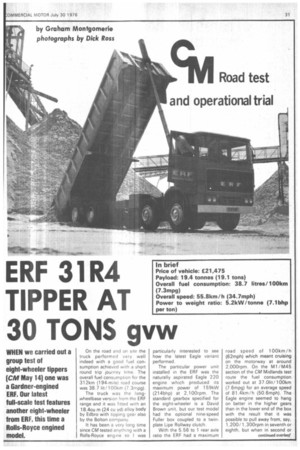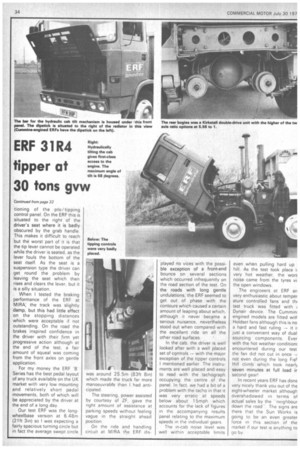ERF 31R4 TIPPER AT 30 TONS gvw
Page 33

Page 34

Page 36

If you've noticed an error in this article please click here to report it so we can fix it.
On the road and on site the truck performed very well indeed with a good fuel consumption achieved with a short round trip journey time. The overall fuel consumption for the 312km (194-mile) road course was 38.7 lit/100km (7.3mpg).
The truck was the I ong,wheelbase version from the ERF range and it was fitted with an 18.4cu m (24 cu yd) alloy body by Edbro with tipping gear also by the Bolton company.
It has been a very long time since CM tested anything with a Rolls-Royce engine so I was
particularly interested to see how the latest Eagle variant performed.
The particular power unit installed in the ERF was the naturally aspirated Eagle 220 engine which produced its maximum power of 159kW (214bhp) at 2,10.0rpm. The standard gearbox specified for the eight-wheeler is a David Brown unit, but our test model had the optional nine-speed Fuller box coupled to a twinplate Lipe Rollway clutch.
With the 5.56 to 1 rear axle ratio the ERF had a maximum
road speed of 100km /h (62mph) which meant cruising on the motorway at around 2,000rpm. On the M1 /M45 section of the CM Midlands test route the fuel consumption worked out at 37.01it /100km (7.6mpg) for an average speed of 81.4km /h (50.6mph). The Eagle engine seemed to hang on better in the higher gears than in the lower end of the box with the result that it was possible to pull away from, say, 1,200/1,300rpm in seventh or eighth, but when in second or third it was advisable not to let the revs drop below about 1,500rpm. The rapid die down of the Rolls engine coupled with the slick gearchange made the Eagle/Fuller combination a very well matched unit which made life. easy for the driver.
On the A-road sections of the route, cruising at around the 40 mark meant 1,500rpm for the engine which is right on the point of the power curve which gives maximum efficiency. From the end of the motorway to the finish at Hemel Hempstead, the ERF returned a fuel consumption of 39.81it/100km (7.1mpg) which is very good when it is remembered that this section includes some very severe gradients such as Fish Hill out of Broadway.
One has to be very careful not to read too much into the fuel consumption and average speed figures for a tipper. The saying "horses for courses"' was never more true than when applied to on/off-road machines. Some operators whose type of operation includes lots of site work and relatively little on-road running will probably opt for the lower
axle ratio of 6.11. Our particular truck was fitted with the 5.56 axle which makes it more suitable for the operator with a greater proportion of highway running.
The choice of axle ratios was reflected in the hill climbing ability of the ERF. On the test hills at MIRA, the 1 in 6 was climbed from rest satisfactorily but the 1 in 5 proved too much. On the other hand, the top speed of the truck made it a useful vehicle for motorways. By playing around with the different axle ratios available with the Fuller or David Brown gearbox options the operator should be able to come up with the specification most suitable to his needs.
The overall fuel consumption for the 312km (194-mile) Mid lands test route was 38.71it/100km (7.3mpg) which was achieved with the very high average speed of 55.8 km/h (34.7mph) although it must be admitted that the traffic around the course was much lighter than usual.
The eight-wheeler uses the SP cab which is identical to the one featured in our road test of the Cummins-engined tractive unit published last January. It uses glassfibre panels mounted on a steel subframe and the whole tilts hydraulically to a maximum angle of 68 which gives excellent accessibility to the power unit and its ancillary equipment. This angle of tilt also allows the engine to be winched out in a straight pull for major overhaul..
Routine level checking is carried out through the hinged front panel. (This panel also provides a convenient storage place for the lever for the hydraulic tilt mechanism.) One minor point of interest is that the dipstick is on the right of the radiator as one faces the truck on the Rolls model compared with on the left as on the Cummins version.
While talking about accessibility I must mention the crazy situation relating to the posicontinued on page 34 tioning of the pto / tipping control panel. On the ERF this is situated to the right of the driver's seat where it is badly obscured by the grab handle. _This makes it difficult to reach but the worst part of it is that the tip lever cannot be operated while the driver is seated, as the lever fouls the bottom of the seat itself. As the seat is a suspension type the driver can get round the problem by leaving the seat which then rises and clears the lever, but it is a silly situation.
When I tested the braking performance of the ERF at MIRA; the track was slightly damp, but this had little effect on the stopping distances which were acceptable if not outstanding. On the road the brakes inspired confidence in the driver with their firm yet progressive action although at the end of the test, a fair amount of squeal was coming from the front axles on gentle application.
For my money the ERF 'Br Series has the best pedal layout of any truck available on the UK market with very low mountino and relatively short pedal movements, both of which will be appreciated by the driver at the end of a long day.
Our test ERF was the longwheelbase version at 6.48m (21ft 3m) so I was expecting a fairly spacious turning circle but in fact the average swept circle was around 25.5m (83ft Bin) which made the truck far more manoeuvrable than I had anticipated The steering, power assisted by courtesy of ZF, gave the right amount of assistance at parking speeds without feeling vague in the straight ahead position.
On the ride and handling circuit at MIRA the ERF played no vices with the possible exception of a front-end bounce on several sections which occurred infrequently on the road section of the test On the roads with long gentle undulatrons, the ERF seemed to get out of phase with the contours which caused a certain amount of leaping about which, although it never became a serious nuisance, nevertheless stood out when compared with the excellent ride on all the other road surfaces.
In the cab, the driver is well looked after with a well placed set of controls -with the major exception of the tipper controls I mentioned earlier. The instruments are well placed and easy to read with the tachograph occupying the centre of the panel. In fact, we had a bit of a problem with the tacho in that it was very erratic at speeds below about 15mph which accounts for the lack of figures in the accompanying results panel relating to the maximum speeds in the individual gears The in-cab noise level was well within acceptable limits
even when pulling hard up hill. As the test took place Ii very hot weather, the wore noise came from the tyres vi. the open windows.
The engineers at ERF ari very enthusiastic about temper ature controlled fans and thi test truck was fitted with Dynair device. The Cummini engined models are fitted witt Holdset fans although this is no a hard and fast ruling -it ir just a convenient way of dual sourcing components. Ever with the hot weather conditiom encountered during our test the fan did not cut in once not even during the long Fisl' Hill climb which took nearly seven minutes at full load ir second gearl
In recent years ERF has donE very nicely thank you out of thE eight-wheeler market although overshadowed in terms of actual sales by the "'neighbour down the road-. The signs are there that the Sun Works is going to he an even greater force in this section of the market if our test is anything to go by




















































































